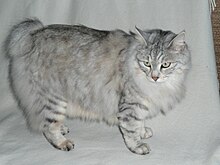| Kurilian Bobtail | |
|---|---|
 A semi-long-haired specimen | |
| Other names | Kuril Islands Bobtail, Kurilean Bobtail Kuril Bobtail, Curilsk Bobtail |
| Origin | |
| Breed standards | |
| FIFe | standard |
| TICA | standard |
| WCF | standard |
| Notes | |
Some registries divide Kurilians into separate shorthair and longhair breeds. | |
| Domestic cat (Felis catus) | |
| Nicknames | pumpkin |
|---|---|
| Traits | |
| Weight |
|
| Coat | double layered |
| Color | red to grey to yellow to brown |
| Litter size | 2 to 3 |
| Lifespan | 15-20 years |
| Fur type | short to semi-longhair |
| Bobtail | 2 to 5 inches |
The Kurilian Bobtail is a cat breed (or breed group, depending on registry) originating from the Russian Kuril Islands, as well as Sakhalin Island and the Kamchatka peninsula of Russia.[1][2] Short- or long-haired, it has a semi-cobby body type and a distinct short, fluffy tail. The back is slightly arched with hind legs longer than the front, similar to those of the Manx.[2] The breed is also called the Kuril Islands Bobtail, Kuril Bobtail (both often misspelled "Kurile") and Curilsk Bobtail, and may be referred to without "Bobtail". It is sometimes also spelled Kurilean.[3] The original short-haired variant is a natural breed,[2][3] known on the islands for over 200 years.[2] As selectively bred pets, they have been popular in USSR and to some extent other parts of Europe, especially for their rodent-hunting abilities, since the middle of the 20th century,[2] but remained rare in North America[2] as of 2011[update].
Kurilians are recognized as a breed group of a pair related short- and [semi-]long-haired breeds by The International Cat Association (TICA), which considers them "Advanced New Breeds" ineligible for championship status,[4] as of 2011[update]) and by the Fédération Internationale Féline (FIFe). The World Cat Federation (WCF) recognizes them as a single breed.[citation needed] As of 2011[update], the Cat Fanciers' Association (CFA) did not recognize the breed at all.
While possibly closely related to the Japanese Bobtail breed – both share the same kind of kinked, short tail, but the Japanese is leaner, more angular and less cobby[1][5] – the Kurilian originated on the opposite side of Eurasia from the similarly named Karelian Bobtail of western Russia and Finland, and is thus unlikely to be a near relative. Genetic studies may eventually demonstrate the breed's connection to others. Just as the Japanese Bobtail and tailless-to-short-tailed Manx arose independently on islands a world apart, the Kurilian's bobbed tail may be an isolated spontaneous mutation that became common on the Kuril and Sakhalin islands because of the limited genetic diversity of island biogeography (an example of the founder effect and, at the sub-specific level, of the species-area curve).
- ^ a b "Kurilian Bobtail Breed Group (KB/KBL)" (PDF). TICA.org. Harlingen, Texas: The International Cat Association (TICA). 2008. Archived from the original (PDF) on 2011-11-01. Retrieved 2011-12-12.
- ^ a b c d e f "TICA Kurilian Bobtail Breed Introduction". TICA.org. op. cit. 2011. Archived from the original on 2012-01-15. Retrieved 2011-11-24.
- ^ a b "Kurilean Bobtail Longhair/Shorthair: KBL/KBS" (PDF). FIFeWeb.org. Fédération Internationale Féline (FIFe). 1 January 2010. Archived from the original (PDF) on 2 March 2017. Retrieved 2011-12-12.
- ^ "TICA-Recognized Cat Breeds". TICA.org. op. cit. 2011. Archived from the original on 2014-02-13. Retrieved 2011-11-24.
- ^ "Japanese Bobtail Breed Group (JB/JBL)" (PDF). TICA.org. op. cit. 2009. Archived from the original (PDF) on 2011-11-03. Retrieved 2011-12-12.